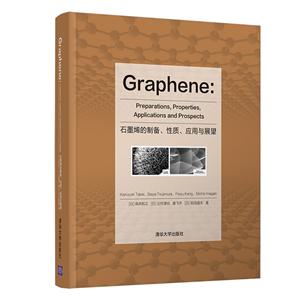石墨烯的制备、性质、应用与展望 版权信息
- ISBN:9787302556213
- 条形码:9787302556213 ; 978-7-302-55621-3
- 装帧:一般胶版纸
- 册数:暂无
- 重量:暂无
- 所属分类:>>
石墨烯的制备、性质、应用与展望 本书特色
石墨烯是从石墨中提取的一种新型碳材料,具有非同寻常的机械性能和物理性能。本书从材料制备、性能评价、各种开发和应用技术等方面详细讨论了这种新型材料的研究进展,探讨了这种材料的发展前景和技术路径。本书非常适合高校和科研院所材料科学及物理、电子等专业的师生及生产企业的工程技术人员阅读参考。
国内外顶级专业人员的倾情奉献,令读者脑洞智力大开的热门读物国内外顶级专业人员的倾情奉献,令读者脑洞智力大开的热门读物
石墨烯的制备、性质、应用与展望 内容简介
石墨烯是一种新型碳材料, 具有非同寻常的机械性能和物理性能。本书从材料制备、性能评价、各种开发和应用技术等方面详细讨论了这种新型材料的研究情况, 并探讨了这种材料的发展前景和技术路径。
石墨烯的制备、性质、应用与展望 目录
Contents
Preface .............................................................................................................v
Acknowledgments ..............................................................................................vii
Chapter 1: Introduction......................................................................................1
1.1 What is graphene?.................................................................................................. 1
1.2 Fundamentals of materials science for carbon materials ..................................... 5
1.2.1 Classi.cation of carbon materials ..................................................................... 5
1.2.2 Structure and nanotexture of carbon materials.................................................6
1.2.3 Carbonization and graphitization ...................................................................... 8
1.2.4 Carbon materials .............................................................................................. 12
1.3 Construction and purposes of the current book..................................................29
References................................................................................................................... 31
Chapter 2: Preparation of graphene .................................................................. 39
2.1 Chemical vapor deposition .................................................................................. 41
2.1.1 Synthesis of graphene .lms............................................................................. 41
2.1.2 Synthesis of graphene .akes ........................................................................... 60
2.1.3 Synthesis of single-walled carbon nanohorns.................................................65
2.1.4 Substitutional doping of heteroatoms.............................................................. 69
2.1.5 Graphene foams ............................................................................................... 80
2.2 Cleavage (peeling) ............................................................................................... 81
2.2.1 Mechanical cleavage........................................................................................81
2.2.2 Cleavage in solution ........................................................................................ 85
2.2.3 Cleavage via intercalation compounds............................................................95
2.3 Exfoliation via graphene oxide.......................................................................... 101
2.3.1 Synthesis of graphene oxide..........................................................................102
2.3.2 Exfoliation of graphene oxide ....................................................................... 105
2.3.3 Reduction of graphene oxide......................................................................... 107
2.3.4 Fabrication of reduced graphene oxide foams (sponges).............................123
2.3.5 Functionalization of reduced graphene oxide...............................................127
2.3.6 Substitutional doping of heteroatoms............................................................ 133
2.3.7 Fabrication of transparent reduced graphene oxide .lms ............................ 135
2.4 Other processes .................................................................................................. 138
2.4.1 Chemical synthesis......................................................................................... 138
i
Contents
2.4.2 Synthesis via pyrolysis .................................................................................. 143
2.4.3 Unzipping of carbon nanotubes..................................................................... 147
2.5 Concluding remarks ........................................................................................... 150
References................................................................................................................. 153
Chapter 3: Electrical properties and applications .............................................. 173
3.1 Fundamental electrical properties...................................................................... 174
3.1.1 Electronic structure of graphene ................................................................... 174
3.1.2 Effects of defects and edges..........................................................................181
3.2 Applications to information technology............................................................189
3.2.1 Transistor devices........................................................................................... 189
3.2.2 Spintronics devices ........................................................................................ 207
3.2.3 Transparent electrode.....................................................................................221
3.3 Applications to social .elds .............................................................................. 226
3.3.1 Sensor devices................................................................................................226
3.3.2 Photon detectors.............................................................................................233
3.3.3 Resistance standard........................................................................................237
3.3.4 Electron .eld emission .................................................................................. 242
3.4 Concluding remarks ........................................................................................... 244
References................................................................................................................. 244
Chapter 4: Chemical properties and applications............................................... 251
4.1 Fundamental chemical properties......................................................................252
4.1.1 Hydrogenation................................................................................................253
4.1.2 Oxygenation ................................................................................................... 256
4.1.3 Layer modi.cation.........................................................................................258
4.2 Applications to energy storage and conversion ................................................ 259
4.2.1 Lithium-ion batteries...................................................................................... 259
4.2.2 Electrochemical capacitors ............................................................................ 268
4.2.3 Lithium-ion capacitors...................................................................................278
4.2.4 Lithium-sulfur batteries ................................................................................. 282
4.2.5 Solar cells (photovoltaic cells) ...................................................................... 292
4.2.6 Fuel cells ........................................................................................................ 298
4.2.7 Hydrogen storage ........................................................................................... 306
4.3 Applications to environment remediation ......................................................... 311
4.3.1 Adsorption of polluting molecules and ions.................................................311
4.3.2 Sorption and recovery of oils ........................................................................ 321
4.3.3 Capacitive deionization for water desalination.............................................325
4.3.4 Catalysts ......................................................................................................... 332
4.3.5 Chemical sensors............................................................................................ 341
4.4 Concluding remarks ........................................................................................... 352
References................................................................................................................. 354
ii
Contents
Chapter 5: Mechanical properties and applications............................................ 373
5.1 Fundamental mechanical properties .................................................................. 374
5.2 Nanolubricants.................................................................................................... 383
5.3 Mechanical sensors ............................................................................................ 387
5.4 Mechanical reinforcement ................................................................................. 393
5.4.1 Reinforcement of plastics .............................................................................. 393
5.4.2 Reinforcement of ceramics............................................................................395
5.4.3 Reinforcement of metals................................................................................ 400
5.5 Reduced graphene oxide .bers.......................................................................... 404
5.6 Concluding remarks ........................................................................................... 409
References................................................................................................................. 410
Chapter 6: Thermal properties and applications................................................ 415
6.1 Fundamental thermal properties ........................................................................ 416
6.2 Thermal interface materials ............................................................................... 422
6.3 Nano.uids........................................................................................................... 429
6.4 Thermoelectric power ........................................................................................ 432
6.5 Thermal energy storage ..................................................................................... 436
6.6 Concluding remarks ........................................................................................... 442
References................................................................................................................. 443
Chapter 7: Biomedical properties and applications ............................................ 449
7.1 Biocompatibility.................................................................................................450
7.2 Cell management................................................................................................ 454
7.2.1 Scaffolds for cell culturing ............................................................................ 454
7.2.2 Stem cell differentiation ................................................................................ 458
7.2.3 Cell imaging...................................................................................................459
7.2.4 Antibacterial activity...................................................................................... 460
7.3 Drug delivery systems........................................................................................ 464
7.4 Biosensors........................................................................................................... 469
7.5 Concluding remarks ........................................................................................... 476
References................................................................................................................. 478
Chapter 8: Beyond graphene........................................................................... 485
8.1 Graphene derivatives..........................................................................................486
8.1.1 Graphane (hydrogenated graphene)............................................................... 487
8.1.2 Fluorographene (.uorinated graphene) ......................................................... 495
8.1.3 Graphene oxide (oxidized graphene) ............................................................ 501
8.1.4 Graphyne and graphdiyne..............................................................................514
8.2 Single-layer materials ........................................................................................ 519
8.2.1 Honeycomb layers of group IV elements...................................................... 519
8.2.2 Honeycomb layers of group IIIeV compounds ........................................... 524
8.2.3 Single layers of transition metal dichalcogenides ........................................ 531
iii
Contents
8.3 Layer-by-layer composites................................................................................. 537
8.4 Concluding remarks ........................................................................................... 544
References................................................................................................................. 546
Chapter 9: Summary and prospects.................................................................561
9.1 Summary on graphene ....................................................................................... 561
9.2 Prospects.............................................................................................................565
9.2.1 Importance of number of layers stacked..................................................... 565
9.2.2 Two kinds of graphene materials ................................................................ 570
9.2.3 Field effect and zero bandgap ..................................................................... 572
9.2.4 Extremely high thermal conductivity..........................................................574
9.2.5 Basics for molecular sensing.......................................................................576
9.2.6 Basics for foreign atom doping...................................................................578
9.2.7 Importance of pep interaction................................................................... 580
9.2.8 Biomedical applications............................................................................... 582
9.2.9 New composite materials............................................................................. 585
9.2.10 Extension to organic chemistry ................................................................... 588
References................................................................................................................. 589
Index ............................................................................................................ 593
展开全部
石墨烯的制备、性质、应用与展望 作者简介
The authors of this book are composed of two persons who have been working on carbon materials, published many research papers and recently published three books on carbon materials on their fundamentals, advances and characterizations (M. Inagaki and F. Kang) and two persons who have been working on graphene from the standpoints of physics (K. Takai), and biochemical applications (S. Tsujimura). The book is going to be written under the corporation of four authors by sharing the responsibilities on whole






















